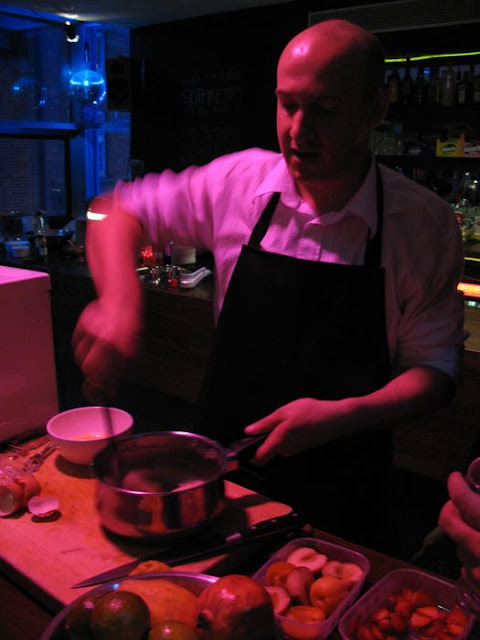This is a version of a Heston Blumenthal chocolate tart. It has a biscuit base laced with popping candy and is topped with a chocolate and passion fruit ganache and all covered in a crisp chocolate icing and dusted with cocoa. I opted to add some little balls of passion fruit jelly to snazz it up a bit, just in case anyone might have thought it looked a bit on the plain side.
The popping candy in the biscuit base really is an amazing feature, it's slow to kick in but when it does you don't quite know whats going on, and the passion fruit in the chocolate is divine. It's an intense fruitiness and just the right balance of sweetness and sharpness. If you treat yourself to a really good bar of chocolate such as Amedei or Valrhona (particularly any of their single estate ranges) then you'll find they will often have an intense fruitiness and aroma of berries that's comparable to a good wine. There's a similar depth of flavour to the chocolate ganache here which comes through from the passion fruit.
Here's the recipe. I made it double quantity in a bigger tin. I was a bit concerned that there wasn't actually much ganache but in fact when you tuck in you'll find it's plenty.
As is usually the case with Heston recipes there's a bit of fancy kit required to do the job properly, in this case, a compressor powered paint spray gun which you're supposed to fill with chocolate and oil and use to give a smooth finish coat to the whole thing. This requires you to fully freeze the cake first, the idea being that when the atomised chocolate spray hits the frozen cake that it sets instantly. I don't have an electric spray gun. In case you think that one of those hand pump garden spray things might work as an alternative....take it from me, don't bother, and they're a nightmare to wash out after a failed attempt as well.
But you do need a coating on this cake because where the biscuit base and ganache meet it looks a bit messy. As an alternative to the spray gun I ended up freezing the tart as directed in the recipe and then simply melting 200g of chocolate with 50g of butter and using it to coat the outside. I put about a third of this into a small shallow rimmed dish. With the cake frozen I was able to hold it up vertically on its side and rotate it round like a wheel through the chocolate in the dish to coat the sides of the cake. I then pored the remainder of the chocolate over to coat the top. You have to work very quick to spread it and smooth it out as it will set firm in no time. Check out I want to cook like Heston for another bloggers dilemma on how to finish this cake without a spray gun.
I had brought a cute little ice cube tray from Muji a while back that makes little ice marbles. I'd always figured it would make a great little mould for jellies and took the opportunity to try it out here for the first time. So the jellies are just passion fruit pulp (blended to separate from the seeds and then sieved) and a little sugar syrup and gelatin. I realised that I'd have to freeze these in order to be able to pop them out the moulds without destroying them. You can see the frost on them in the photo but as they thawed they took on a real translucent glow. To sit them into the cake I used the back of a melon baller dipped in hot water just to press down and create a divot into which the jelly balls would sit and not roll out. And for good measure I dusted the whole thing in cocoa powder before popping on the jellies to finish.
At the last hour I discovered that the outer coating of chocolate was prone to cracking unevenly as it was sliced so I had to be sure to cut it using a large knife dipped in bolling water and wiped clean after each cut.

I actually made this as my entry to my work place bake off. Despite stiff competition it won me first pize! Here it is on the way to the office.



















































